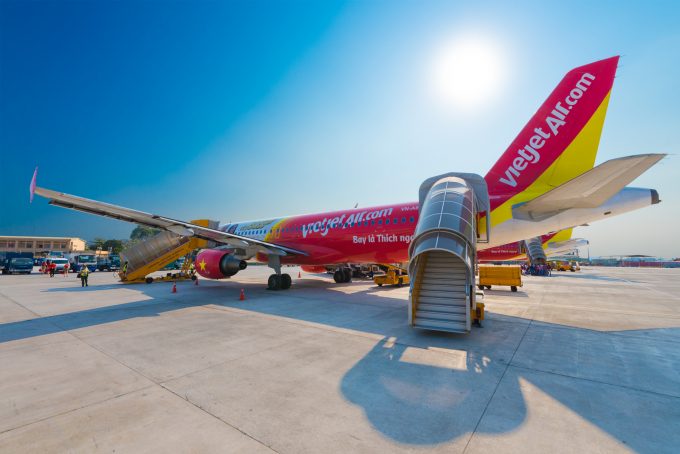2025 will be 'quite a ride' – but logistics will 'again prove its value'
With tariff-induced transport shifts set to cause supply chain complexity, 2025 “is going to be ...
FDX: ABOUT USPS PRIVATISATIONFDX: CCO VIEWFDX: LOWER GUIDANCE FDX: DISRUPTING AIR FREIGHTFDX: FOCUS ON KEY VERTICALFDX: LTL OUTLOOKGXO: NEW LOW LINE: NEW LOW FDX: INDUSTRIAL WOESFDX: HEALTH CHECKFDX: TRADING UPDATEWMT: GREEN WOESFDX: FREIGHT BREAK-UPFDX: WAITING FOR THE SPINHON: BREAK-UP ALLUREDSV: BREACHING SUPPORTVW: BOLT-ON DEALAMZN: TOP PICK
FDX: ABOUT USPS PRIVATISATIONFDX: CCO VIEWFDX: LOWER GUIDANCE FDX: DISRUPTING AIR FREIGHTFDX: FOCUS ON KEY VERTICALFDX: LTL OUTLOOKGXO: NEW LOW LINE: NEW LOW FDX: INDUSTRIAL WOESFDX: HEALTH CHECKFDX: TRADING UPDATEWMT: GREEN WOESFDX: FREIGHT BREAK-UPFDX: WAITING FOR THE SPINHON: BREAK-UP ALLUREDSV: BREACHING SUPPORTVW: BOLT-ON DEALAMZN: TOP PICK

Vietjet Air Cargo will launch its first freighter service in October as, according to CEO Do Xuan Quang, Vietnam’s air cargo industry continues a strong growth trajectory.
“We are planning to buy or lease a freighter and really build up our cargo operations,” he told The Loadstar.
With a Korean express logistics company as its first customer, Vietjet’s initial freighter services will concentrate on South-east Asia, with Singapore, Bangkok, Hong Kong and Manila likely destinations, according to Mr Do.
Vietjet has expanded rapidly since its bikini-clad launch in 2011, building up a fleet of 41 aircraft in less than six years. Last year, the carrier recorded a 39% increase in revenue to $1.23bn, while passenger numbers jumped 50% to over 14m.
Vietjet’s $170m IPO in February saw it become Vietnam’s largest airline by market capitalisation, overtaking flag-carrier Vietnam Airlines. The IPO has reportedly made Vietjet founder Nguyen Thi Phuong Thao Asia’s first self-made female billionaire.
“Our chairwoman is very ambitious. After five years we’ve been very successful: from just one or two aircraft we now have over 40 and we will have 100 by 2020,” said Mr Do.
“But the belly capacity of the passenger aircraft is too small, with only two or three tonnes. Many cargo commodities are palletised and need bigger capacity aircraft, so we need a freighter.”
After initially launching on South-east Asian tradelanes, Mr Do said Vietjet planned to add longer intra-Asia destinations, including Tokyo, Incheon, and Shanghai, and eventually further afield to Dubai.
“After that’s successful, we’ll go further, to Europe – Frankfurt, Amsterdam, London, Paris – and also to New York. This is our big plan for the future.”
Addressing delegates at the Air Freight Logistics Vietnam conference in Ho Chi Minh City on Saturday, Mr Do outlined the extent of the country’s booming aviation sector and looming capacity crunch.
Vietnam’s current throughput of 1.4m freight tonnes is expected to nearly double to 2.5m by 2020. Last year, domestic traffic grew 16% to 400,000 tonnes and exports reached 355,000 tonnes, up some 18%. China dominates Vietnam’s imports with around 26% market share, followed by South Korea (20%) and the US (9%).
Mr Do described the congestion at the capital’s Tan Son Nhat Airport as “terrible” and due to its limited space of only 51 aircraft parking slots.
Indeed, he said the government had warned Vietjet to “slow down” its fleet expansion, given its plan to purchase 150 aircraft within the next five years.
Similarly, Vietnam’s fifth airline, Vietstar, was told this month it would not receive an operating licence until the airport’s current expansion was complete. Work on additional parking slots, a runway and a new terminal is due for completion by 2019.
However, Mr Do said the proposed Long Thanh International Airport, in neighbouring Dong Nai province, will provide a longer-term solution.
“We need a new airport not in the city, like now. The government has seen this but we need $18bn in funding. And Hanoi will break through 1m tonnes by 2019, so we need another terminal there too or it’s not enough.”
Meanwhile, despite the apparent collapse of the Trans-Pacific Partnership, from which Vietnam was expected to greatly benefit from increased US trade, Mr Do said free-trade agreements with the EU and Eurasian Economic Union would nevertheless boost Vietnam’s export-led economy.
“I’m very positive for the outlook. We have the opportunity in Vietnam with freighters; we can all make money – ground handlers, airlines, freight forwarders – it’s a win-win-win.
“But government policy is very important,” he added.
Comment on this article